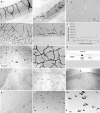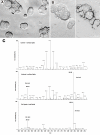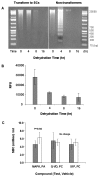Straw blood cell count, growth, inhibition and comparison to apoptotic bodies
- PMID: 18492269
- PMCID: PMC2397387
- DOI: 10.1186/1471-2121-9-26
Straw blood cell count, growth, inhibition and comparison to apoptotic bodies
Abstract
Background: Mammalian cells transform into individual tubular straw cells naturally in tissues and in response to desiccation related stress in vitro. The transformation event is characterized by a dramatic cellular deformation process which includes: condensation of certain cellular materials into a much smaller tubular structure, synthesis of a tubular wall and growth of filamentous extensions. This study continues the characterization of straw cells in blood, as well as the mechanisms of tubular transformation in response to stress; with specific emphasis placed on investigating whether tubular transformation shares the same signaling pathway as apoptosis.
Results: There are approximately 100 billion, unconventional, tubular straw cells in human blood at any given time. The straw blood cell count (SBC) is 45 million/ml, which accounts for 6.9% of the bloods dry weight. Straw cells originating from the lungs, liver and lymphocytes have varying nodules, hairiness and dimensions. Lipid profiling reveals severe disruption of the plasma membrane in CACO cells during transformation. The growth rates for the elongation of filaments and enlargement of rabbit straw cells is 0.6 approximately 1.1 (microm/hr) and 3.8 (microm(3)/hr), respectively. Studies using apoptosis inhibitors and a tubular transformation inhibitor in CACO2 cells and in mice suggested apoptosis produced apoptotic bodies are mediated differently than tubular transformation produced straw cells. A single dose of 0.01 mg/kg/day of p38 MAPK inhibitor in wild type mice results in a 30% reduction in the SBC. In 9 domestic animals SBC appears to correlate inversely with an animal's average lifespan (R2 = 0.7).
Conclusion: Straw cells are observed residing in the mammalian blood with large quantities. Production of SBC appears to be constant for a given animal and may involve a stress-inducible protein kinase (P38 MAPK). Tubular transformation is a programmed cell survival process that diverges from apoptosis. SBCs may be an important indicator of intrinsic aging-related stress.
Figures





References
Publication types
MeSH terms
Substances
LinkOut - more resources
Full Text Sources

